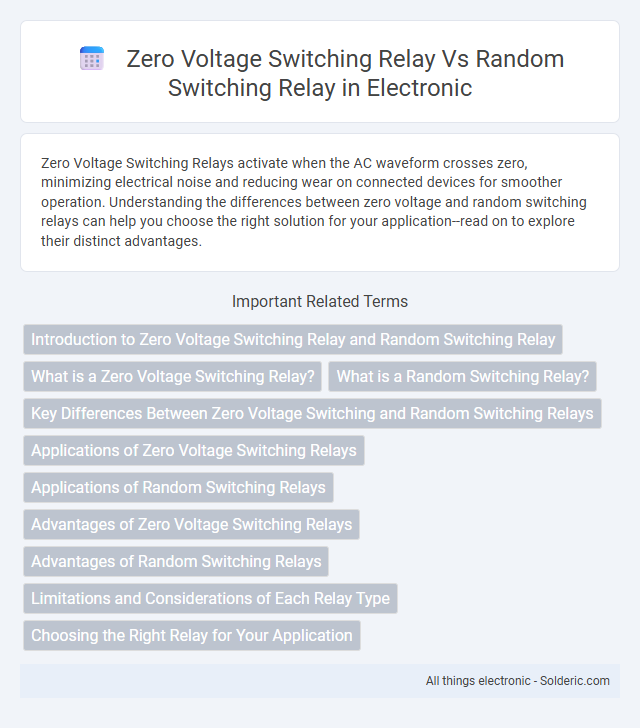Zero Voltage Switching Relays activate when the AC waveform crosses zero, minimizing electrical noise and reducing wear on connected devices for smoother operation. Understanding the differences between zero voltage and random switching relays can help you choose the right solution for your application--read on to explore their distinct advantages.
Comparison Table
| Feature | Zero Voltage Switching Relay | Random Switching Relay |
|---|---|---|
| Switching Method | Switches at zero voltage crossing point | Switches at any point of AC cycle |
| Electrical Noise | Minimal electrical noise and EMI | Higher electrical noise and EMI |
| Contact Wear | Reduced contact wear due to soft switching | Increased contact wear due to switching under load |
| Power Efficiency | Improved power efficiency and reduced losses | Lower power efficiency |
| Application | Ideal for sensitive loads and power-saving applications | Suitable for non-critical loads |
| Cost | Higher cost due to advanced control circuitry | Lower cost and simpler design |
| Example Uses | Lighting control, HVAC systems, and motor drives | Basic switching applications without timing control |
Introduction to Zero Voltage Switching Relay and Random Switching Relay
Zero Voltage Switching Relay operates by switching electrical loads precisely when the AC voltage crosses zero, minimizing electrical noise and reducing stress on components. Random Switching Relay, in contrast, switches the load at any point in the AC cycle without synchronization to the voltage waveform, which can cause higher electromagnetic interference and wear. Understanding the differences between these relays helps you select the appropriate device for applications requiring minimized electrical interference and extended relay longevity.
What is a Zero Voltage Switching Relay?
A Zero Voltage Switching (ZVS) relay is designed to switch electrical loads precisely when the AC voltage waveform crosses the zero-voltage point, minimizing arcing and electrical noise. This relay enhances the longevity of both the relay contacts and the connected devices by reducing inrush current and electromagnetic interference. Compared to random switching relays, ZVS relays provide smoother operation, improved energy efficiency, and better protection for sensitive electronic components.
What is a Random Switching Relay?
A Random Switching Relay operates by switching electrical loads at any point in the AC cycle without synchronizing to the zero voltage crossing, which can result in higher electrical noise and increased electromagnetic interference (EMI). Unlike Zero Voltage Switching Relays that minimize switching transients by activating at zero volts, Random Switching Relays are simpler and cost-effective but may cause more stress on components and potential disturbances in sensitive circuits. If your application tolerates higher switching noise and requires a basic relay function, a Random Switching Relay may suit your needs.
Key Differences Between Zero Voltage Switching and Random Switching Relays
Zero Voltage Switching (ZVS) relays activate when the AC load voltage crosses zero, reducing electrical noise and minimizing contact wear for enhanced durability. Random Switching Relays operate without regard to the voltage waveform, potentially causing higher electromagnetic interference and increased mechanical stress. Your choice between these relays impacts system efficiency, noise levels, and relay lifespan depending on the application's sensitivity to switching transients.
Applications of Zero Voltage Switching Relays
Zero Voltage Switching (ZVS) relays are ideal for applications requiring reduced electrical noise and prolonged contact life, such as in lighting systems, motor controls, and industrial automation. Your systems benefit from minimal electromagnetic interference and smoother switching transitions, making ZVS relays essential in sensitive electronic environments and precision equipment. Unlike Random Switching Relays, ZVS relays optimize performance by activating contacts precisely at the zero crossing point of the AC waveform, enhancing efficiency and reliability.
Applications of Random Switching Relays
Random Switching Relays are commonly used in applications where minimizing electromagnetic interference and prolonging relay contact life are essential, such as audio equipment, telecommunications, and sensitive measurement instruments. These relays operate without waiting for zero-crossing points, allowing faster switching and greater flexibility in controlling loads with variable frequencies or irregular waveforms. Your choice of a random switching relay can enhance performance in systems requiring rapid response times and reliable switching under diverse operating conditions.
Advantages of Zero Voltage Switching Relays
Zero Voltage Switching (ZVS) relays minimize electrical noise and reduce contact wear by switching at the zero-crossing point of the AC waveform, enhancing the relay's lifespan and reliability. Your circuits benefit from lower electromagnetic interference (EMI) and improved energy efficiency, making ZVS relays ideal for sensitive and high-performance applications. Compared to Random Switching Relays, ZVS relays offer superior switching accuracy and reduced heat generation, promoting overall system stability.
Advantages of Random Switching Relays
Random switching relays provide advantages such as reduced electromagnetic interference (EMI) due to their non-synchronized switching times, which help minimize electrical noise in sensitive circuits. They offer improved reliability in applications with varying load conditions by preventing repetitive stress on relay contacts. These relays also support enhanced flexibility in control systems, accommodating diverse signal timing requirements without the constraint of zero-cross detection.
Limitations and Considerations of Each Relay Type
Zero Voltage Switching (ZVS) relays minimize electrical noise and extend device lifespan by activating only when the AC voltage crosses zero, but they may struggle with load variability and slower switching speeds. Random Switching Relays offer faster response times and greater load flexibility but can generate significant electrical noise, causing potential interference and reduced relay longevity. Your choice depends on balancing noise reduction with switching speed and load characteristics for optimal performance.
Choosing the Right Relay for Your Application
Zero Voltage Switching (ZVS) relays reduce electrical noise and prolong component lifespan by switching at the moment the voltage crosses zero, making them ideal for sensitive electronics and inductive loads. Random Switching Relays switch without voltage phase consideration, offering faster response times but potentially increasing electromagnetic interference and wear. Selecting the right relay depends on your application's priority for noise reduction, reliability, and switching speed.
Zero Voltage Switching Relay vs Random Switching Relay Infographic

 solderic.com
solderic.com